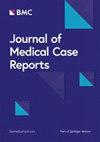一名服用喹硫平和法莫替丁的患者出现史蒂文斯-约翰逊综合征--中毒性表皮坏死:病例报告
IF 0.9
Q3 MEDICINE, GENERAL & INTERNAL
引用次数: 0
摘要
史蒂文斯-约翰逊综合征-毒性表皮坏死(SJS-TNE)重叠症是一种罕见的皮肤病,其特征是红斑、水疱、大面积脱皮、表皮脱落、多处粘膜受累和尼克尔斯基征阳性。SJS-TEN 的死亡率很高。我们的病例是一起罕见的由药物诱发的史蒂文斯-约翰逊综合征-毒性表皮坏死症重叠病例,患者在接受喹硫平和法莫替丁治疗时发病较晚。一名 82 岁的台湾女性因尿量减少、全身水肿、多处皮肤水疱和褥疮入院。随着病变的进一步扩散,面部、躯干和四肢出现多处破裂的水疱,并伴有浅表糜烂,粘膜受累面积占体表总面积的20%。尼克尔斯基体征呈阳性。诊断结果高度怀疑是史蒂文-约翰逊综合征。一个月前,她开始服用法莫替丁和喹硫平。她开始接受甲基强的松龙静脉注射治疗,3 天后皮损有所好转。然而,甲泼尼龙减量仅 1 天后,又出现了新的皮损。患者在入院 12 天后死亡。史蒂文斯-约翰逊综合征-中毒性表皮坏死溶解症是一种罕见的皮肤病。虽然它主要是急性的,而且死亡率很高,但仍有可能延迟发病。喹硫平和法莫替丁治疗老年病和胃肠道疾病通常是安全有效的,但罕见的药物超敏反应可导致衰弱的后果。因此,提高临床认识和启动支持性护理势在必行。目前仍缺乏最佳管理指南,需要通过随机对照试验来确认已制定的指南。有必要开展合作,以制定更好的管理策略。本文章由计算机程序翻译,如有差异,请以英文原文为准。
Stevens–Johnson syndrome-toxic epidermal necrolysis overlap in a patient taking quetiapine and famotidine: a case report
Stevens–Johnson syndrome-toxic epidermal necrolysis (SJS-TNE) overlap is a rare skin disorder characterized by erythema, blisters, extensive exfoliation, epidermal detachment, the involvement of multiple mucosae, and positive Nikolsky’s sign. SJS-TEN has a high mortality rate. Our case involves a rare occurrence of drug-induced Stevens–Johnson syndrome-toxic epidermal necrolysis overlap with a delayed onset in the setting of quetiapine and famotidine therapy. An 82-year-old Taiwanese female was admitted to our hospital for decreased urine output, generalized edema, and multiple skin blisters and bedsores. With further spread of the lesions, multiple ruptured bullae with shallow erosions on the face, trunk, and limbs and mucosal involvement affected 20% of the total body surface area. Nikolsky’s sign was positive. A diagnosis of Steven–Johnson syndrome was highly suspected. One month prior, she had started famotidine and quetiapine. Intravenous methylprednisolone treatment was initiated, which ameliorated the skin lesions after 3 days. However, new lesions developed after only 1 day of methylprednisolone tapering. The patient died 12 days after admission. Stevens–Johnson syndrome-toxic epidermal necrolysis is a rare skin disorder. Although it is mainly acute and has a high mortality rate, delayed onset can still occur. Quetiapine and famotidine are generally safe and effective for treating geriatric and gastrointestinal problems, but rare drug hypersensitivity reactions can lead to debilitating consequences. Therefore, increased clinical awareness and the initiation of supportive care are imperative. Optimal management guidelines are still lacking, and confirmation of developed guidelines through randomized controlled trials is needed. Collaboration for better management strategies is warranted.
求助全文
通过发布文献求助,成功后即可免费获取论文全文。
去求助
来源期刊

Journal of Medical Case Reports
Medicine-Medicine (all)
CiteScore
1.50
自引率
0.00%
发文量
436
期刊介绍:
JMCR is an open access, peer-reviewed online journal that will consider any original case report that expands the field of general medical knowledge. Reports should show one of the following: 1. Unreported or unusual side effects or adverse interactions involving medications 2. Unexpected or unusual presentations of a disease 3. New associations or variations in disease processes 4. Presentations, diagnoses and/or management of new and emerging diseases 5. An unexpected association between diseases or symptoms 6. An unexpected event in the course of observing or treating a patient 7. Findings that shed new light on the possible pathogenesis of a disease or an adverse effect
 求助内容:
求助内容: 应助结果提醒方式:
应助结果提醒方式:


